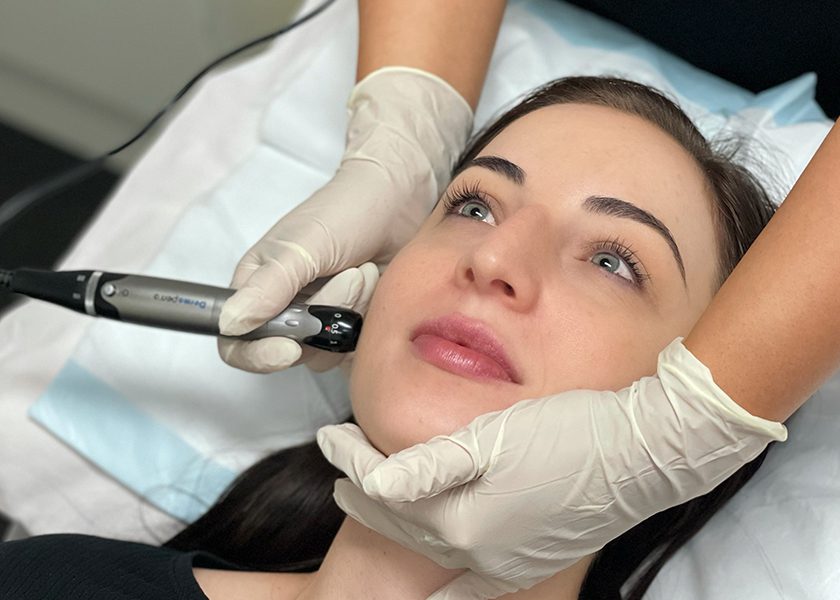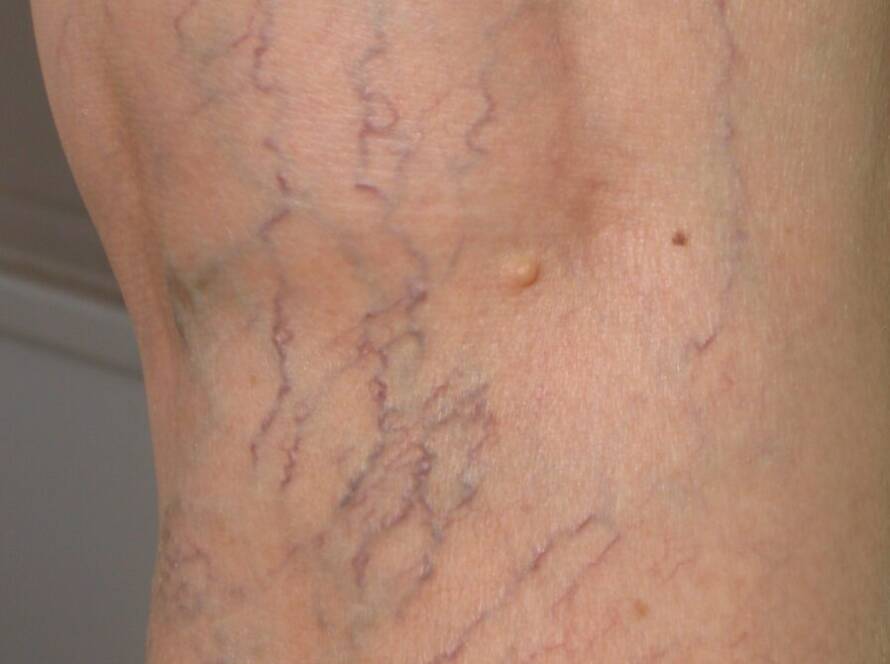Noticing fine red or purple lines weaving across your cheeks or nose? Spider veins on your face can appear just beneath the skin’s surface, creating a web of visible capillaries.
While completely harmless, these dilated blood vessels can be frustrating when they become more noticeable or difficult to cover.
The key to managing them lies in understanding the root cause and exploring the best treatment options for your skin.
At Laser Skin and Vein in Adelaide, we specialise in minimally invasive, non-surgical therapies designed to refresh and restore your complexion.
Here, we’ll explain what spider veins are, their symptoms, risk factors, treatment options, and tips for prevention. Read on to discover how to achieve clearer, calmer and more comfortable skin.
What are spider veins on the face?
Spider veins on the face, or telangiectasia, are tiny, broken blood vessels that appear just beneath the skin’s surface, forming a branch-like pattern. Despite their name, they are not actual veins but rather damaged capillaries, venules, and arterioles—small blood vessels that link to larger veins.
These broken blood vessels are more visible because they are closer to the skin than deeper veins. They typically appear red, blue, or purple and are most common on the face and legs. While harmless, many people seek treatment for cosmetic reasons.
Facial spider veins are often caused by sun exposure, which weakens blood vessels over time. That said, other factors can also contribute, including rosacea, liver conditions, connective tissue disorders (such as lupus or scleroderma), prolonged corticosteroid use, and pregnancy.
Symptoms of spider veins
Spider veins are usually a cosmetic concern rather than a painful condition, but in some cases, they can cause mild discomfort.
While their most noticeable feature is a web-like appearance, some people may also experience additional symptoms, including:
- Cramping
- Itching
- Burning sensation
- Swelling
- Tired or heavy legs
- Dull, aching pain
- Changes in skin texture or colour
Because all blood vessels in the body are interconnected, spider veins on the face can sometimes indicate underlying vein conditions, like varicose veins, chronic venous insufficiency, or deep vein thrombosis. If discomfort persists or worsens, it’s important to seek medical advice.
Risk factors of spider veins on the face
Flawless, radiant skin is a beauty goal for many, but broken capillaries can stand in the way. Understanding their risk factors can help you maintain a luminous, even complexion.
The main causes of spider veins on the face include:
- Sun exposure: Excessive sun exposure weakens blood vessels, causing them to expand and become more visible. Sunburn can also make facial veins more noticeable as the top layer of skin peels.
- Genetics: A family history of spider veins increases the likelihood of developing them. If your parents or relatives have facial veins, you may be more prone to them.
- Ageing: As skin naturally loses elasticity and becomes thinner with age, underlying blood vessels are more likely to become visible.
- Hormonal changes: Fluctuations in hormone levels, particularly increased estrogen during pregnancy, menopause, or from birth control use, can contribute to spider veins. Pregnancy-related facial veins often fade after childbirth.
- Alcohol consumption: Alcohol temporarily dilates blood vessels, causing redness in the face. Frequent or excessive drinking can lead to permanently broken capillaries.
- Rosacea: Rosacea and other skin conditions cause persistent facial redness and flushing, which can weaken capillaries over time, leading to visible veins.
- Weather changes: Hot temperatures cause blood vessels to expand, while cold weather can lead to sudden contraction, both of which may contribute to broken capillaries.
- Injuries and bruising: Facial trauma, even minor bumps, can damage blood vessels and make them more visible, especially in areas with thinner skin.
- Sneezing or vomiting: Forceful sneezing, vomiting, or excessive coughing can create pressure in the face, leading to broken blood vessels.
- Weight gain: Extra weight puts additional pressure on blood vessels, which may increase their visibility, particularly in the face.
- Medications: Blood pressure medications, oral contraceptives, and other drugs that affect circulation can contribute to spider veins by causing vessel dilation.
How to get rid of spider veins on the face
Laser therapy

Laser therapy is a non-invasive treatment for minimising the look of facial spider veins. This advanced technique uses concentrated light energy to break down unwanted blood vessels without damaging the surrounding skin.
At our clinic, we use the K-laser to treat spider veins on the face. This high-precision laser targets oxyhaemoglobin—the red pigment in blood cells—within the affected veins. In turn, the cells heat up, coagulate and are eliminated via the lymphatic system. Ultimately, this process seals off the capillary and fades from view.
During treatment, a trained professional will glide a handheld device over the target area, delivering pulses of laser light. This procedure is quick, and many clients notice an immediate improvement in the appearance of spider veins.
After laser therapy, your skin may appear slightly flushed, but this typically settles within a few hours. You can apply makeup immediately, allowing you to return to your daily routine with ease. Sun protection is essential—using a high-quality SPF helps maintain your results and supports your skin’s natural beauty.
If you’re considering laser therapy, book a consultation with our dedicated team to determine if it’s the right option for your skin.
Sclerotherapy
Sclerotherapy is a minimally invasive treatment designed to minimise the appearance of spider veins on the face, with research suggesting that it can lead to a 50% to 70% reduction in visibility.
This procedure involves carefully injecting a specialised solution into the affected blood vessel, prompting it to collapse and be naturally absorbed by the body. As a result, blood flow is redirected to healthier, less visible veins, helping to create a more balanced look.
Typically taking around 30 minutes, the treatment is generally well-tolerated, with little discomfort and no significant downtime.
If you’d like to minimise the appearance of facial spider veins, a consultation at Laser Skin And Vein can help determine if sclerotherapy is suitable for your skin.
Dermal needling

Dermal needling, also known as skin needling or microneedling, is designed to enhance skin texture, boost collagen, and promote a more youthful complexion.
Using an advanced pen-like device with ultra-fine needles, this treatment creates controlled micro-channels in the skin to stimulate natural collagen and elastin production.
While often sought for its ability to soften fine lines, improve skin tone, and reduce acne scars, dermal needling may assist in minimising the appearance of broken capillaries.
That’s because collagen plays a key role in maintaining skin strength and elasticity, and its production may help support the skin’s structure over time.
This gentle yet effective treatment is designed to refresh and revitalise, leaving skin feeling firmer, smoother, and more refined. If you are interested in this treatment, book a consultation at our Adelaide clinic to explore whether it is the right way forward for your skin.
Intense Pulsed Light therapy
Intense Pulsed Light (IPL) therapy is a popular non-invasive treatment for spider veins on the face.
It works similarly to laser therapy by using targeted light energy to heat and break down unwanted blood vessels. Over time, the body naturally absorbs these damaged capillaries, leading to a clearer and more even complexion.
Unlike traditional laser treatments, IPL emits a broad spectrum of light wavelengths, allowing it to penetrate deeper into the skin without harming the surface layer.
This makes it an effective option for treating spider veins while also addressing other skin concerns like redness, pigmentation, and uneven tone.
IPL treatments are generally well-tolerated, with minimal downtime. However, temporary redness, slight swelling, or mild discomfort may occur post-treatment.
At Laser Skin And Vein, our highly-trained team of Doctors and Nurses can help determine whether IPL is the right approach for your skin type and concerns.
What are the benefits of facial vein treatment?
If you are concerned about visible facial veins on the face, professional treatment may help refresh and enhance your complexion.
Here are some of the potential benefits:
Greater comfort
Sensitive or tender areas caused by facial veins may feel more at ease with the right treatment, helping your skin feel calm and refreshed.
A brighter, more balanced complexion
Visible veins can contribute to redness or uneven skin tone, particularly in response to heat or stress. Treatment can help support a more balanced appearance, allowing your natural glow to shine.
Healthier skin
Addressing facial veins may help reduce irritation in the affected areas, supporting your skin’s overall appearance and well-being.
Every complexion is unique, and seeking advice from a qualified professional ensures you receive the most suitable care for your skin. If you’re considering facial vein treatment, an expert consultation can help guide you towards options tailored to your individual needs.
How to prevent spider veins on the face
While treating visible facial veins can restore confidence in your complexion, prevention is just as important.
While it’s not always possible to avoid broken blood vessels entirely, certain habits can help reduce the likelihood of them developing:
Wear sun protection
Sun exposure can weaken blood vessels, making them more prone to breaking. Apply a broad-spectrum SPF50 sunscreen daily, wear a hat, and avoid direct sun during peak hours (late morning to early afternoon) to help maintain an even, radiant complexion.
Avoid heat exposure
High temperatures from saunas, hot baths, and even extreme weather can cause blood vessels to dilate. Where possible, opt for warm—not hot—water when cleansing your face and be mindful of excessive heat exposure.
Shield your face
If you engage in activities such as cycling, sports, or outdoor adventures, wearing protective gear can help minimise the risk of facial injuries that may lead to broken blood vessels.
Use gentle skincare products
Aggressive scrubbing and harsh exfoliants can irritate delicate facial skin, making it more vulnerable to spider veins. Choose gentle skincare products and techniques to protect your skin’s natural barrier.
Limit alcohol consumption
Alcohol can temporarily dilate blood vessels, and excessive consumption may lead to permanent spider veins over time. If you drink, moderation is key.
Consider a smoke-free lifestyle
Smoking can impact circulation and weaken blood vessels, increasing the risk of visible veins. If you smoke, quitting may offer benefits not only for your skin but also for your overall well-being.
Book a consultation for facial spider vein treatment in Adelaide

Spider veins on the face are a common concern that many people experience at some point in their lives. While they may feel frustrating, it’s reassuring to know that they are usually a cosmetic issue rather than a health concern.
With the right skincare, sun protection, and lifestyle choices, you can help prevent them from forming. And for those already present, advanced in-clinic treatments are a gentle way to support a more balanced complexion.
If you wish to enhance your natural beauty by reducing the appearance of spider veins, the dedicated team at Laser Skin and Vein is here to guide you.
We offer tailored treatments with little to no downtime, including laser therapy, sclerotherapy, and dermal needling.
Contact us to book a consultation in Adelaide today. Our specialists will assess your skin and guide you through your treatment options.
References
- Parlar B, Blazek C, Cazzaniga S, Naldi L, Kloetgen HW, Borradori L, Buettiker U. Treatment of lower extremity telangiectasias in women by foam sclerotherapy vs. Nd:YAG laser: a prospective, comparative, randomized, open-label trial. J Eur Acad Dermatol
- Venereol. 2015 Mar;29(3):549-54. doi: 10.1111/jdv.12627. Epub 2014 Jul 28. PMID: 25069999.Atefeh M. A microneedling device for the treatment of spider vein: A case report. J Cosmet Dermatol. 2021 Aug;20(8):2571-2573. doi: 10.1111/jocd.13858. Epub 2020 Dec 3. PMID: 33270981.



